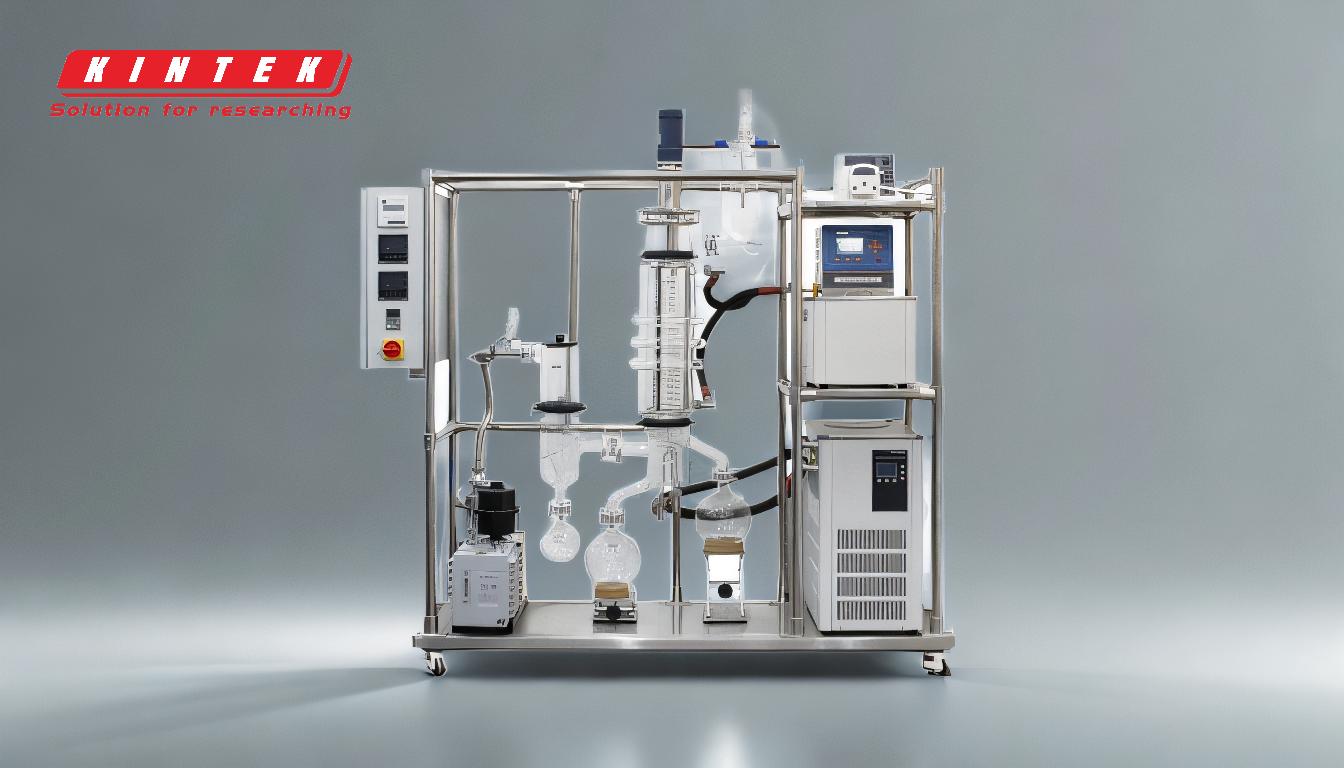Molecular distillation is a specialized separation technique used to purify and concentrate thermally sensitive materials, such as high molecular weight compounds or volatile substances like fish oil. The process operates under high vacuum conditions, ensuring that the distance between the heating and condensing surfaces is less than the mean free path of the molecules. This allows lighter molecules to evaporate, travel a short distance, and condense on a separate surface, while heavier molecules return to the liquid phase. The process involves forming a thin liquid film on a heated surface, evaporating the molecules, moving them to a condensing surface, and collecting the separated distillates and residues. It is widely used in industries requiring high-purity separation, such as pharmaceuticals, food, and cosmetics.
Key Points Explained:

-
Formation of a Liquid Film:
- The process begins by creating a thin liquid film on the heated surface of the distillation apparatus. This is achieved by spreading the feed material using mechanisms like PTFE wipers, which move at high speeds (e.g., 3 m/s) to ensure uniform distribution.
- The thin film maximizes the surface area for evaporation and ensures efficient heat transfer, which is critical for the success of the distillation process.
-
Free Evaporation of Molecules:
- Under high vacuum conditions, the liquid film is heated, causing the molecules to evaporate freely from the surface. The low pressure ensures that the molecules can escape without boiling, which is particularly important for thermally sensitive materials.
- The evaporation is driven by the difference in the mean free path of the molecules. Lighter molecules, with longer mean free paths, escape more readily than heavier molecules.
-
Movement of Molecules to the Condensing Surface:
- After evaporation, the molecules travel a short distance to the condensing surface. This distance is carefully controlled to be less than the mean free path of the molecules, ensuring that lighter molecules reach the condensing surface while heavier molecules do not.
- The condensing surface is maintained at a lower temperature to facilitate the condensation of the evaporated molecules.
-
Condensation of Molecules:
- Upon reaching the condensing surface, the evaporated molecules condense back into a liquid state. This step separates the lighter, more volatile components from the heavier, less volatile ones.
- The condensed liquid is collected as the distillate, which is the purified product of the process.
-
Collection of Distillates and Residues:
- The final step involves collecting the distillate (condensed product) and the residue (un-evaporated material). The residue, which contains the heavier molecules, is often recirculated through the system for further distillation to maximize yield and purity.
- This step ensures that the process is efficient and that the desired level of separation is achieved.
-
Applications and Benefits:
- Molecular distillation is particularly useful for processing thermally sensitive materials, such as fish oil, essential oils, and high molecular weight compounds. It preserves the integrity of heat-sensitive components, such as beneficial fatty acids in fish oil.
- The process is also energy-efficient, as it operates at lower temperatures and requires minimal heating time compared to traditional distillation methods.
-
Safety Considerations:
- The process is inherently hazardous due to the use of flammable materials and high vacuum conditions. Proper handling and safety measures, such as explosion-proof equipment and rigorous monitoring, are essential to mitigate risks.
By following these steps, molecular distillation achieves high-purity separation of complex mixtures, making it an invaluable tool in industries requiring precise and gentle processing of sensitive materials.
Summary Table:
| Key Step | Description |
|---|---|
| Formation of a Liquid Film | Thin liquid film created on a heated surface using PTFE wipers for uniform heat distribution. |
| Free Evaporation | Molecules evaporate under high vacuum, driven by differences in mean free paths. |
| Movement to Condensing Surface | Lighter molecules travel a short distance to condense, while heavier molecules return. |
| Condensation | Evaporated molecules condense on a cooler surface, separating volatile components. |
| Collection | Distillate (purified product) and residue (un-evaporated material) are collected. |
| Applications | Used for fish oil, essential oils, and high molecular weight compounds. |
| Safety | Requires explosion-proof equipment and rigorous monitoring due to high vacuum and flammability. |
Discover how molecular distillation can enhance your process—contact our experts today!









